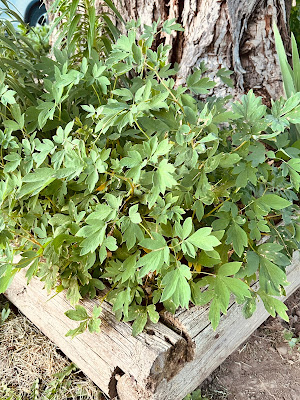There are several species of bleeding hearts, one variety is native to the United States, but the variety mentioned here is native to China, Korea and Siberia and was later well established in Japan. As early as 1810 this unique plant made its way into Europe, by the then famous Scottish botanist Robert Fortune. It was subsequently lost, until it was brought back in 1846 by the Royal Horticulture Society on exploratory trips East. The unique shape, color and foliage of the plant earned it favor among royalty and commoners alike and was soon planted all over Europe. As more and more people immigrated from Europe and Asia into the newly developing colony states and later the United States, they brought with them many of the plants they so loved in their home countries. Bleeding hearts among them.
The bleeding heart goes by many names, including lyre flower, lady-in-a-bath, and locks & keys. Each name in some way reflects the unique shape of the bloom. They were once included in the same genus as our native Dutchman’s breeches, and it is easy to see why. Both plants have blossoms that grow like pendants hanging in rows under delicate stems. However, scientists now classify them in another family of plants, that includes the poppies. The delicate flower is shaped like our most famous symbol of love, hearts, and varies in color from pink to deep fuchsia. These slightly puffy blooms resemble tiny lanterns with two white inner petals and a stamen peeking out underneath. These inner petals appear to be dripping from the lantern. They have a delicate sweet scent and are showy in any spring garden. They prefer shade to partial shade but will tolerate sun in cooler climates.
Homeopathic healers recognize the medicinal value of the bleeding heart and often create remedies to treat coughing, dizziness, and skin disorders. May also be used as stimulants or diuretics. However, this plant is considered toxic to humans as well as pets, like dogs and should not be consumed in any way, as it contains isoquinoline alkaloids and may cause trembling, convulsions, diarrhea, and vomiting as well as breathing issues. Even handling the plant should only be done while wearing gloves as the secretions of the plant may cause skin irritations. Leave the home remedies up to the experts.
Several legends surround this spectacular plant, one of which originates in China where it is said a Jade maiden named Si Jun, who was originally a minor deity and considered virtuous as well as beautiful. Si Jun lived in ancient times, in a beautiful valley between the mountains. She was kind, faithful, wise, and had numerous suitors. However, the loyal Si Jun – her name translates as ‘the one thinking of her lord’ – refused all of them. She had her secret love, a beautiful and handsome young man. Her beloved was a soldier, encamped far from her and forbidden to communicate with his love and send her answers in letters. The faithful and patient Si Jun waited for his return. While waiting, she would dedicate herself to embroidery. Once a month, she would embroider a purse she dedicated to her lover. The embroidered purse would hang on the branch of a peony tree by her window. Her embroidery was so beautiful and real, that it tricked bees and butterflies. The bees and butterflies would try to pollinate the artificial motifs on the purse, and it continued for so long that the peony tree gave new, heart-shaped flowers. The gods made it into a new plant, the one Chinese legend refers to as the ’purse peony’. The story of Si Jun inspired a custom of giving this plant as a precious love promise or even a proposal of marriage since the flower has a shape like a bridal purse. The symbolism of the ’purse peony’ in China is similar to that of red roses in European culture.
Another legend begins in Japan where it is said a noble prince was smitten with a selfish, but beautiful princess. He tried in vain to win her love, he frequently brought her extravagant gifts from his worldly travels. Yet she took no notice of him. Returning from a long journey, bearing with him special gifts, he felt sure would win her heart. First, he gave her two magical pink bunnies (peel off the outer two petals and set them on their side to reveal little bunnies). The princess only sighed, not impressed. The prince did not lose hope and presented her with a beautiful pair of enchanted earrings (remove the two long white petals and hold them to your ear). She happily accepted the gift, but declared she could not love him. Still unable to give up hope he made her a gift of slippers from delicate silk (inner two petals). The princess barely took notice and again declared she could never love him. Defeated and forlorn, the prince had no choice but to give up. He rose up and pulled a dagger from his sheath and stabbed himself in the heart (remaining in the flower is a heart shape with a stamen that appears as a dark green line down the center, hold the heart up and carefully remove the dagger-like line and plunge it though the heart). The princess was overcome by the devotion of the young prince and his unending love for her. She then realized too late that she loved him too. “Alas” she cried out “I have done a wrong, my own heart is broken also, I shall bleed for my prince ever more. Her heart bleeds to this day.
Try pressing
the heart-shaped blossoms between the pages of a book to dry. They will become
perfectly shaped paper-thin hearts, any valentine or loved one would cherish in
a message of love. The bleeding heart, favored by royalty, steeped in legend
both beautiful and tragic is a beautiful addition to any shade garden.







No comments:
Post a Comment